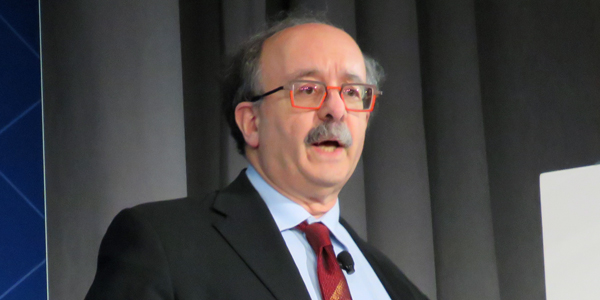By Rich Heidorn Jr.
NEW YORK — Amory Lovins knows the conventional wisdom on energy efficiency. And he doesn’t buy it.
Economic theory says you stop investing in EE when the heat savings from insulation, for example, no longer outweighs the costs. But “integrative design” — optimizing buildings, vehicles and factories as whole systems rather than individual parts — changes the equation, he says.
Lovins, the visionary founder of the Rocky Mountain Institute, ascribes to Dwight Eisenhower’s advice: “If a problem cannot be solved, enlarge it.” Expanding the boundaries of the problem uncovers new options and synergies, he says.
Thus, he told the Bloomberg New Energy Finance’s Future of Energy Summit last week that electric intensity — which he said dropped a record 4.4% in 2017 — could fall even more dramatically in the future.
“If you keep investing well beyond that supposed cost-effectiveness limit, suddenly your marginal cost goes back down because now your house loses so little heat that it no longer needs a furnace, ducts, fans, pipes, pumps, wires, controls [and] fuel-supply arrangements,” Lovins said.
Lovins displayed a photo of him with his latest harvest of bananas, grown in his 35-year-old passive solar home near Aspen, Colo. “Integrative design saved 99% of its heating energy and $1,100 of construction cost because the super insulation, super windows and so on cost less than the heating system they displaced,” he said. “Now over 160,000 European buildings do this.”
Fat, Short and Straight
Lovins cited the 2011 retrofits to the Empire State Building. Replacing 6,000 leaky windows with ones that pass light but block heat, plus improved lighting and office equipment, cut the skyscraper’s energy costs by 38% and the peak cooling load by a third. “Then renovating smaller chillers instead of adding bigger ones saved over $17 million in capital cost, paying for most of those savings and cutting the payback to three years — the same payback as saving a sixth as much energy with standard disintegrative design.”
Three years later, Lovins said, the retrofit of an office building in Denver reduced energy costs by 70%, “making this half-century old federal office more efficient than what was then the best new U.S. office, which in turn is less than half as efficient as [RMI’s] own net positive, no mechanicals office. And now there’s a German building using three-fifths less energy than ours.”
The results were not from new technology, he said, but from design improvements. Making pipes and ducts “fat, short and straight rather than skinny, long and crooked as in normal practice,” he said, eliminates at least 80% of the friction and energy consumption. “If that were done worldwide, it could save about half the world’s coal-fired electricity. The payback is typically less than a year in retrofit and zero in new build. But this is hardly noticed because it’s not a technology, it’s a design method.”
He also cited the engineers on the Tesla Model S, who realized batteries work better if prewarmed. “Many other components also needed heat added or removed at various times, so rather than separately heating or cooling each, they were all choreographed so that in each stage of driving, thermally linked coolant loops shuttle heat around from where it’s not wanted to where it is. That means longer [battery] range, lower weight, lower cost. And not needing the radiator for first 50 km — which is longer than most trips — keeps it shuttered until needed, further improving aerodynamics.”
An All-Renewables ERCOT
Lovins said ERCOT could address its steep late-afternoon ramp rate — the so-called “dead armadillo curve” — by moving to 100% distributed renewables, with 86% wind and solar PV, and the remaining 14% supplied by dispatchable renewables, including burning animal manure in existing gas turbines.
“Then match the load by putting the surplus electricity into two kinds of distributed storage worth buying anyway, namely ice storage air conditioning and smart charging of [electric vehicles]. And then recovering that energy when needed and filling the last gaps with unobtrusively flexible demand yields 100% renewable energy every hour of the year,” he said. “Five percent annual spill, very low prices using no bulk storage but eight cheaper kinds of grid flexibility resources.
“Efficiency is not a dwindling, rising-cost resource like copper,” he concluded. “Energy efficiency resources are ubiquitous and infinitely expandable assemblages of ideas depleting nothing but stupidity — a very abundant resource. So, to all you smart designers, I give you this charge: Blessed be your negawatts. Go forth and be fruitful and subtract.”





